High-Resolution Spatiotemporal Water Use Mapping of Surface and Direct-Root-Zone Drip-Irrigated Grapevines Using UAS-Based Thermal and Multispectral Remote Sensing
Abstract
1. Introduction
2. Materials and Methods
2.1. Study Site
2.2. Imaging Campaigns
2.3. METRIC Implementation
2.4. Soil-Water-Balance- and Grapevine Basal-Crop-Coefficient-Derived Evapotranspiration
2.5. Water Use Analysis
3. Results
3.1. Evapotranspiration and Transpiration Mapping
3.1.1. UASM and LM Approaches
3.1.2. UASM and SWB Approaches
3.1.3. UASM and Basal Crop-Coefficient (FAO-Kcb) Approaches
3.2. Effect of DRZ Irrigation Treatments
3.3. Seasonal Water Use
4. Discussion
5. Conclusions
Author Contributions
Funding
Acknowledgments
Conflicts of Interest
References
- McCarthy, M.G. Developmental variation in sensitivity of Vitis vinifera L. (Shiraz) berries to soil water deficit. Aust. J. Grape Wine Res. 2000, 6, 136–140. [Google Scholar] [CrossRef]
- Santesteban, L.G.; Miranda, C.; Royo, J.B. Regulated deficit irrigation effects on growth, yield, grape quality and individual anthocyanin composition in Vitis vinifera L. cv. ‘Tempranillo’. Agric. Water Manag. 2011, 98, 1171–1179. [Google Scholar] [CrossRef]
- Styles, J.; Stevens, R.; Grigson, G.; Ewenz, C.; Williams, C. Seasonal Variation of Crop Water Use, Soil Water Balance and Vine Transpiration in a Riverland Vineyard. SARDI Publication Number F2009/000000-1; South Australian Research and Development Institute: Urrbrae, Australia, 2015. [Google Scholar]
- Yunusa, I.A.M.; Walker, R.R.; Lu, P. Evapotranspiration components from energy balance, sap flow and microlysimetry techniques for an irrigated vineyard in inland Australia. Agric. For. Meteorol. 2004, 127, 93–107. [Google Scholar] [CrossRef]
- Ferreira, M.I.; Silvestre, J.; Conceição, N.; Malheiro, C.A. Crop and stress coefficients in rainfed and deficit irrigation vineyards using sap flow techniques. Irrig. Sci. 2012, 30, 433–447. [Google Scholar] [CrossRef]
- Fooladmand, H.R.; Sepaskhah, A.R. A soil water balance model for a rain-fed vineyard in a micro catchment based on dual crop coefficient. Arch. Agron. Soil Sci. 2009, 55, 67–77. [Google Scholar] [CrossRef]
- Ortega-Farias, S.; Poblete-Echeverria, C.; Brisson, N. Parameterization of a two-layer model for estimating vineyard evapotranspiration using meteorological measurements. Agric. For. Meteorol. 2010, 150, 276–286. [Google Scholar] [CrossRef]
- Rodríguez, J.C.; Grageda, J.; Watts, C.J.; Garatuza-Payan, J.; Castellanos-Villegas, A.; Rodríguez-Casas, J.; Saiz-Hernández, J.; Olavarrieta, V. Water use by perennial crops in the lower Sonora watershed. J. Arid Environ. 2010, 74, 603–610. [Google Scholar] [CrossRef]
- Allen, R.G.; Pereira, L.S.; Raes, D.; Smith, M. FAO Irrigation and Drainage Paper No. 56; Food and Agriculture Organization of the United Nations: Rome, Italy, 1998; Volume 56, p. e156. [Google Scholar]
- Phogat, V.; Skewes, M.A.; McCarthy, M.G.; Cox, J.W.; Šimůnek, J.; Petrie, P.R. Evaluation of crop coefficients, water productivity, and water balance components for wine grapes irrigated at different deficit levels by a sub-surface drip. Agric. Water Manag. 2017, 180, 22–34. [Google Scholar] [CrossRef]
- McShane, R.R.; Driscoll, K.P.; Sando, R. A Review of Surface Energy Balance Models for Estimating Actual Evapotranspiration with Remote Sensing at High Spatiotemporal Resolution over Large Extents. In Scientific Investigations Report 2017; U.S. Department of the Interior, U.S. Geological Survey: Reston, VA, USA, 2017. [Google Scholar]
- Allen, R.G.; Tasumi, M.; Trezza, R. Satellite-based energy balance for mapping evapotranspiration with internalized calibration (METRIC)-Model. J. Irrig. Drain. Eng. 2007, 133, 380–394. [Google Scholar] [CrossRef]
- Allen, R.G.; Tasumi, M.; Morse, A.; Trezza, R.; Wright, J.L.; Bastiaanssen, W.; Kramber, W.; Lorite, I.J.; Robison, C.W. Satellite-based energy balance for mapping evapotranspiration with internalized calibration (METRIC)—Applications. J. Irrig. Drain. Eng. 2007, 133, 395–406. [Google Scholar] [CrossRef]
- Allen, R.; Irmak, A.; Trezza, R.; Hendrickx, J.M.; Bastiaanssen, W.; Kjaersgaard, J. Satellite-based ET estimation in agriculture using SEBAL and METRIC. Hydrol. Process. 2011, 25, 4011–4027. [Google Scholar] [CrossRef]
- Carrasco-Benavides, M.; Ortega-Farías, S.; Lagos, L.; Kleissl, J.; Morales-Salinas, L.; Kilic, A. Parameterization of the satellite-based model (METRIC) for the estimation of instantaneous surface energy balance components over a drip-irrigated vineyard. Remote Sens. 2014, 6, 11342–11371. [Google Scholar] [CrossRef]
- Chandel, A.K.; Molaei, B.; Khot, L.R.; Peters, R.T.; Stöckle, C.O. Small UAS-based multispectral and thermal infrared imagery driven energy balance model for high-resolution evapotranspiration estimation of irrigated field crops. Drones 2020, 4, 52. [Google Scholar] [CrossRef]
- Chávez, J.L.; Torres-Rua, A.; Boldt, W.E.; Zhang, H.; Robertson, C.; Marek, G.; Wang, D.; Heeren, D.; Taghvaeian, S.; Neale, C.M. A Decade of Unmanned Aerial Systems in Irrigated Agriculture in the Western US. Appl. Eng. Agric. 2020, 36, 423–436. [Google Scholar] [CrossRef]
- Santos, C.; Lorite, I.J.; Allen, R.G.; Tasumi, M. Aerodynamic Parameterization of the Satellite-Based Energy Balance (METRIC) Model for ET Estimation in Rainfed Olive Orchards of Andalusia, Spain. Water Resour. Manag. 2012, 26, 3267–3283. [Google Scholar] [CrossRef]
- Paço, T.A.; Pôças, I.; Cunha, M.; Silvestre, J.C.; Santos, F.L.; Paredes, P.; Pereira, L.S. Evapotranspiration and crop coefficients for a super intensive olive orchard. An application of SIMDualKc and METRIC models using ground and satellite observations. J. Hydrol. 2014, 519, 2067–2080. [Google Scholar] [CrossRef]
- Pôças, I.; Paço, T.A.; Cunha, M.; Andrade, J.A.; Silvestre, J.; Sousa, A.; Santos, F.L.; Pereira, L.S.; Allen, R.G. Satellite-based evapotranspiration of a super-intensive olive orchard: Application of METRIC algorithms. Biosyst. Eng. 2014, 128, 69–81. [Google Scholar] [CrossRef]
- Ortega, S. EVALUATION of the METRIC Model for Mapping Energy Balance Components and Actual Evapotranspiration for a Super-Intensive Drip-Irrigated Olive Orchard. Ph.D. Thesis, University of Nebraska-Lincoln, Lincoln, NE, USA, 2019. [Google Scholar]
- la Fuente-Sáiz, D.; Ortega-Farías, S.; Fonseca, D.; Ortega-Salazar, S.; Kilic, A.; Allen, R. Calibration of metric model to estimate energy balance over a drip-irrigated apple orchard. Remote Sens. 2017, 9, 670. [Google Scholar] [CrossRef]
- Carrasco-Benavides, M.; Ortega-Farías, S.; Lagos, L.O.; Kleissl, J.; Morales, L.; Poblete-Echeverría, C.; Allen, R.G. Crop coefficients and actual evapotranspiration of a drip-irrigated Merlot vineyard using multispectral satellite images. Irrig. Sci. 2012, 30, 485–497. [Google Scholar] [CrossRef]
- Cammalleri, C.; Anderson, M.C.; Gao, F.; Hain, C.R.; Kustas, W.P. A data fusion approach for mapping daily evapotranspiration at field scale. Water Resour. Res. 2013, 49, 4672–4686. [Google Scholar] [CrossRef]
- Zipper, S.C.; Loheide II, S.P. Using evapotranspiration to assess drought sensitivity on a subfield scale with HRMET, a high-resolution surface energy balance model. Agric. For. Meteorol. 2014, 197, 91–102. [Google Scholar] [CrossRef]
- Xia, T.; Kustas, W.P.; Anderson, M.C.; Alfieri, J.G.; Gao, F.; McKee, L.; Prueger, J.H.; Geli, H.M.; Neale, C.M.; Sanchez, L.; et al. Mapping evapotranspiration with high-resolution aircraft imagery over vineyards using one-and two-source modeling schemes. Hydrol. Earth Syst. Sci. 2016, 20, 1523–1545. [Google Scholar] [CrossRef]
- Fandino, M.; Cancela, J.J.; Rey, B.J.; Martinez, E.M.; Rosa, R.G.; Pereira, L.S. Using the dual-Kc approach to model evapotranspiration of Albarino vineyards (Vitis vinifera L cv. Albarino) with consideration of active ground cover. Agric. Water Manag. 2012, 112, 75–87. [Google Scholar] [CrossRef]
- Cancela, J.J.; Fandino, M.; Rey, B.J.; Martínez, E.M. Automatic irrigation system based on dual crop coefficient, soil and plant water status for Vitis vinifera (cv Godello and cv Mencía). Agric. Water Manag. 2015, 151, 52–63. [Google Scholar] [CrossRef]
- Ma, X.; Sanguinet, K.A.; Jacoby, P.W. Performance of direct root-zone deficit irrigation on Vitis vinifera L. cv. Cabernet Sauvignon production and water use efficiency in semi-arid southcentral Washington. Agric. Water Manag. 2019, 221, 47–57. [Google Scholar] [CrossRef]
- Ma, X.; Sanguinet, K.A.; Jacoby, P.W. Direct root-zone irrigation outperforms surface drip irrigation for grape yield and crop water use efficiency while restricting root growth. Agric. Water Manag. 2020, 231, 105993. [Google Scholar] [CrossRef]
- Baluja, J.; Diago, M.P.; Balda, P.; Zorer, R.; Meggio, F.; Morales, F.; Tardaguila, J. Assessment of vineyard water status variability by thermal and multispectral imagery using an unmanned aerial vehicle (UAV). Irrig. Sci. 2012, 30, 511–522. [Google Scholar] [CrossRef]
- Espinoza, C.Z.; Khot, L.R.; Sankaran, S.; Jacoby, P.W. High resolution multispectral and thermal remote sensing-based water stress assessment in subsurface irrigated grapevines. Remote Sens. 2017, 9, 961. [Google Scholar] [CrossRef]
- Chávez, J.L.; Gowda, P.H.; Howell, T.A.; Garcia, L.A.; Copeland, K.S.; Neale, C.M.U. ET mapping with high-resolution airborne remote sensing data in an advective semiarid environment. J. Irrig. Drain. Eng. 2012, 138, 416–423. [Google Scholar] [CrossRef]
- Ma, X.; Jacoby, P.W.; Sanguinet, K.A. Improving Net Photosynthetic Rate and Rooting Depth of Grapevines Through a Novel Irrigation Strategy in a Semi-Arid Climate. Front. Plant Sci. 2020, 11, 575303. [Google Scholar]
- Busacca, A.J.; Norman, D.K.; Wolfe, W. Geologic Guide to the Yakima Valley Wine-Growing Region, Benton and Yakima Counties, Washington; Washington State Department of Natural Resources: Washington, DC, USA, 2008.
- Perrier, A. Land surface processes: Vegetation. In Land Surface Processes in Atmospheric General Circulation Models; Eagleson, P.S., Ed.; Cambridge University Press: Cambridge, UK, 1982; pp. 395–448. [Google Scholar]
- Candiago, S.; Remondino, F.; De Giglio, M.; Dubbini, M.; Gattelli, M. Evaluating Multispectral Images and Vegetation Indices for Precision Farming Applications from UAV Images. Remote Sens. 2015, 7, 4026–4047. [Google Scholar] [CrossRef]
- Aboutalebi, M.; Torres-Rua, A.F.; McKee, M.; Kustas, W.; Nieto, H.; Coopmans, C. Behavior of vegetation/soil indices in shaded and sunlit pixels and evaluation of different shadow compensation methods using UAV high-resolution imagery over vineyards. In Autonomous Air and Ground Sensing Systems for Agricultural Optimization and Phenotyping III; International Society for Optics and Photonics: Orlando, Florida, USA, 2018; Volume 10664, p. 1066407. [Google Scholar]
- Jorge, J.; Vallbe, M.; Soler, J.A. Detection of irrigation in homogeneities in an olive grove using the NDRE vegetation index obtained from UAV images. Eur. J. Remote Sens. 2019, 52, 169–177. [Google Scholar] [CrossRef]
- Espinoza, C.Z.; Rathnayake, A.P.; Chakraborty, M.; Sankaran, S.; Jacoby, P.W.; Khot, L.R. Applicability of time-of-flight-based ground and multispectral aerial imaging for grapevine canopy vigour monitoring under direct root-zone deficit irrigation. Int. J. Remote Sens. 2018, 39, 8818–8836. [Google Scholar] [CrossRef]
- Olmedo, G.F.; Ortega-Farías, S.; de la Fuente-Sáiz, D.; Fonseca-Luego, D.; Fuentes-Peñailillo, F. Water: Tools and Functions to Estimate Actual Evapotranspiration Using Land Surface Energy Balance Models in R. R. J. 2016, 8, 352–369. [Google Scholar] [CrossRef]
- Jaafar, H.H.; Ahmad, F.A. Time series trends of Landsat-based ET using automated calibration in METRIC and SEBAL: The Bekaa Valley, Lebanon. Remote Sens. Environ. 2020, 238, 111034. [Google Scholar] [CrossRef]
- Elarab, M. The Application of Unmanned Aerial Vehicle to Precision Agriculture: Chlorophyll, Nitrogen, and Evapotranspiration Estimation. Ph.D. Thesis, Utah State University, Logan, UT, USA, 2016. [Google Scholar]
- van Leeuwen, C.; Friant, P.; Choné, X.; Tregoat, O.; Koundouras, S.; Dubourdieu, D. Influence of climate, soil, and cultivar on terroir. Am. J. Enol. Vitic. 2004, 55, 207–217. [Google Scholar]
- Grigg, D.; Methven, D.; de Bei, R.; Rodríguez López, C.M.; Dry, P.; Collins, C. Effect of vine age on vine performance of Shiraz in the Barossa Valley, Australia. Aust. J. Grape Wine Res. 2018, 24, 75–87. [Google Scholar] [CrossRef]
- Nader, K.B.; Stoll, M.; Rauhut, D.; Patz, C.D.; Jung, R.; Loehnertz, O.; Schultz, H.R.; Hilbert, G.; Renaud, C.; Roby, J.P.; et al. Impact of grapevine age on water status and productivity of Vitis vinifera L. cv. Riesling. Eur. J. Agron. 2019, 104, 1–12. [Google Scholar] [CrossRef]
- Scholasch, T.; Rienth, M. Review of water deficit mediated changes in vine and berry physiology; Consequences for the optimization of irrigation strategies. OENO One 2019, 53. [Google Scholar] [CrossRef]
- Moyer, M.; Mills, L.J. Grapevine Crop Coefficient (Kc); Washington State University Extension: Washington, DC, USA, 2017. [Google Scholar]
- Pearce, I.; Coombe, B.G. Grapevine phenology. In Viticulture Volume 1—Resources, 2nd ed.; Dry, P.R., Coombe, B.G., Eds.; Winetitles: Adelaide, Australia, 2005; pp. 150–166. [Google Scholar]
- Chalmers, Y. Insights into the relationships between yield and water in wine grapes. In Grape and Wine Research and Development Corporation; Department of Agriculture, Fisheries and Forestry of the Government of Australia: Canberra, Australia, 2012. [Google Scholar]
- Poblete-Echeverría, C.A.; Ortega-Farias, S.O. Evaluation of single and dual crop coefficients over a drip-irrigated M erlot vineyard (Vitis vinifera L.) using combined measurements of sap flow sensors and an eddy covariance system. Aust. J. Grape Wine Res. 2013, 19, 249–260. [Google Scholar] [CrossRef]
- Vanino, S.; Pulighe, G.; Nino, P.; De Michele, C.; Bolognesi, S.F.; D’Urso, G. Estimation of evapotranspiration and crop coefficients of tendone vineyards using multi-sensor remote sensing data in a mediterranean environment. Remote Sens. 2015, 7, 14708–14730. [Google Scholar] [CrossRef]
- Dry, P.R.; Loveys, B.R.; During, H. Partial drying of the rootzone of grape. II. Changes in the pattern of root development. Vitis 2000, 39, 9–12. [Google Scholar]
- Kriedemann, P.E.; Goodwin, I. Regulated Deficit Irrigation and Partial Rootzone Drying; Land & Water: Canberra, Australia, 2003. [Google Scholar]
- Munitz, S.; Netzer, Y.; Schwartz, A. Sustained and regulated deficit irrigation of field-grown Merlot grapevines. Aust. J. Grape Wine Res. 2017, 23, 87–94. [Google Scholar] [CrossRef]
- Evett, S.R.; Colaizzi, P.D.; Howell, T.A. Drip and evaporation. In Proceedings of the 2005 Central Plains Irrigation Conference, Sterling, CO, USA, 16–17 February 2007. [Google Scholar]
- Bauerle, T.L.; Smart, D.R.; Bauerle, W.L.; Stockert, C.; Eissenstat, D.M. Root foraging in response to heterogeneous soil moisture in two grapevines that differ in potential growth rate. New Phytol. 2008, 179, 857–866. [Google Scholar] [CrossRef] [PubMed]
- Soar, C.J.; Loveys, B.R. The effect of changing patterns in soil-moisture availability on grapevine root distribution, and viticultural implications for converting full-cover irrigation into a point-source irrigation system. Aust. J. Grape Wine Res. 2007, 13, 2–13. [Google Scholar] [CrossRef]

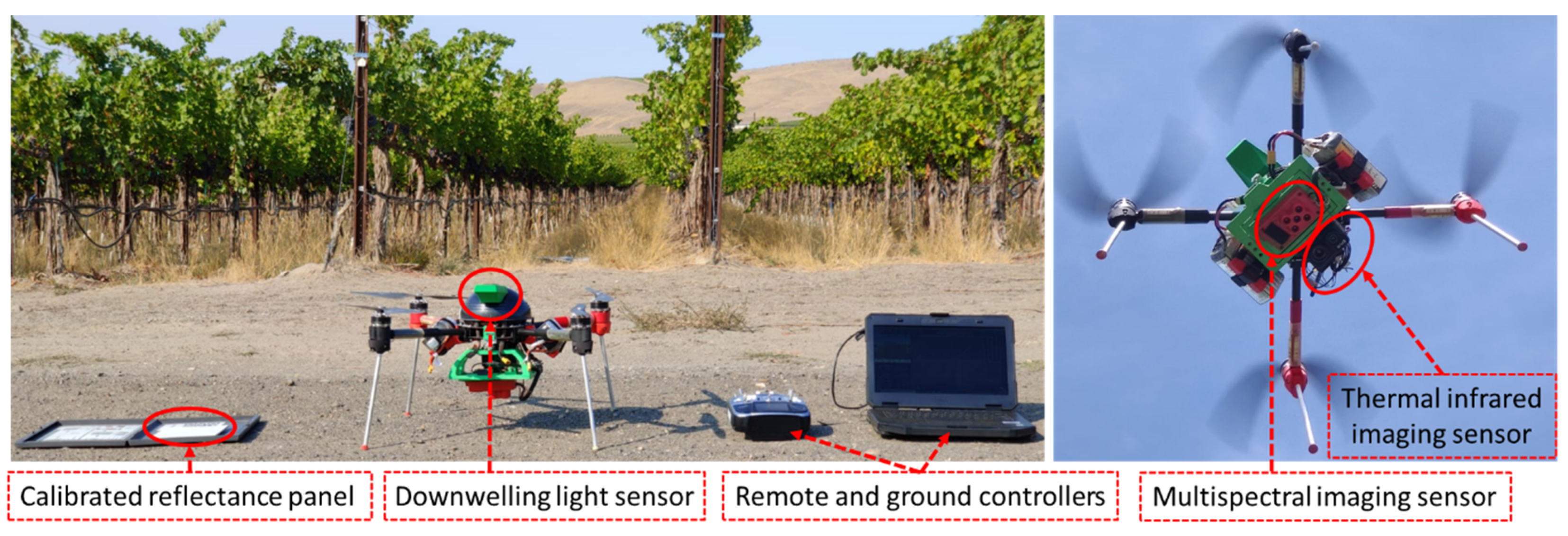
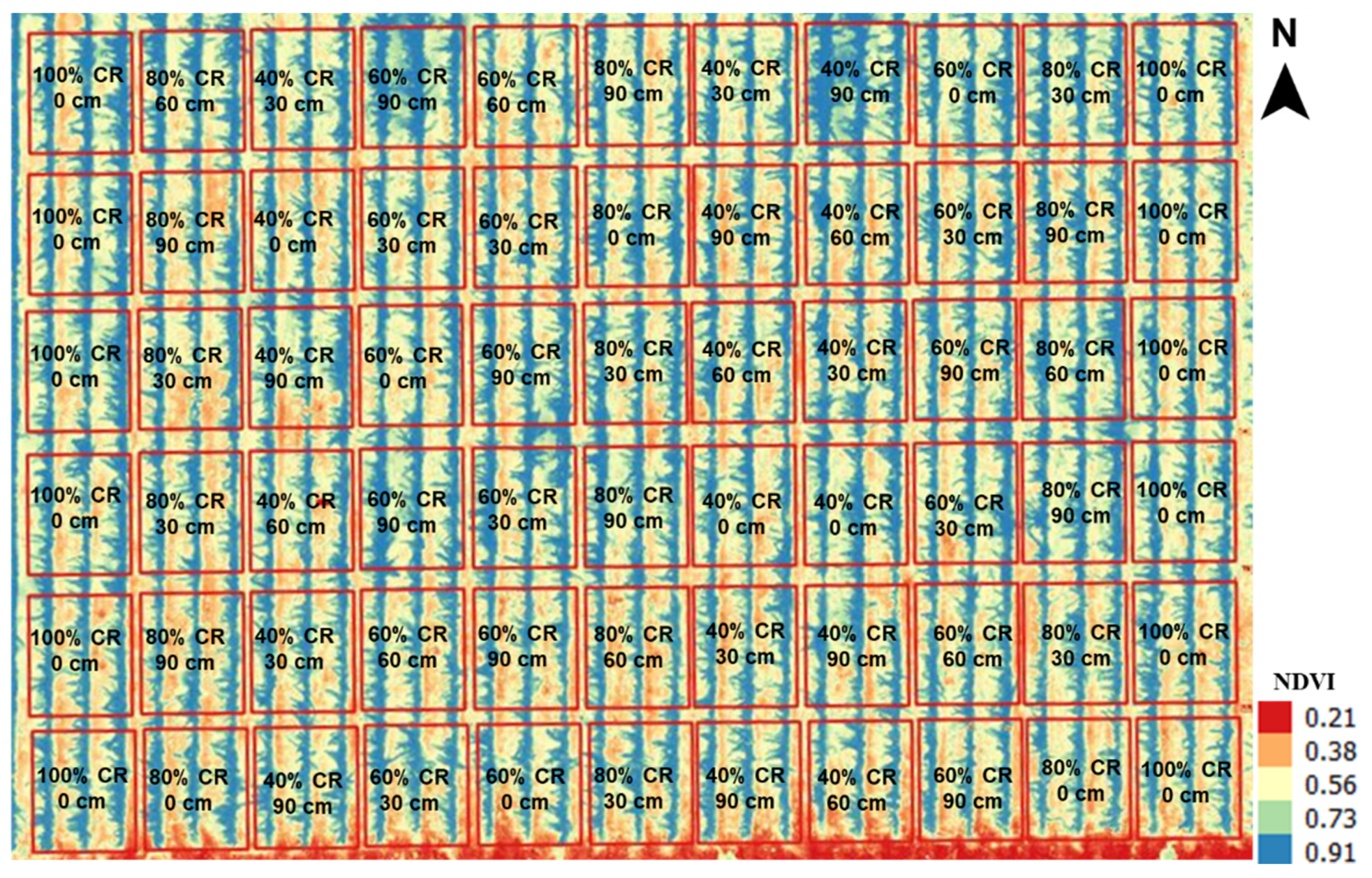
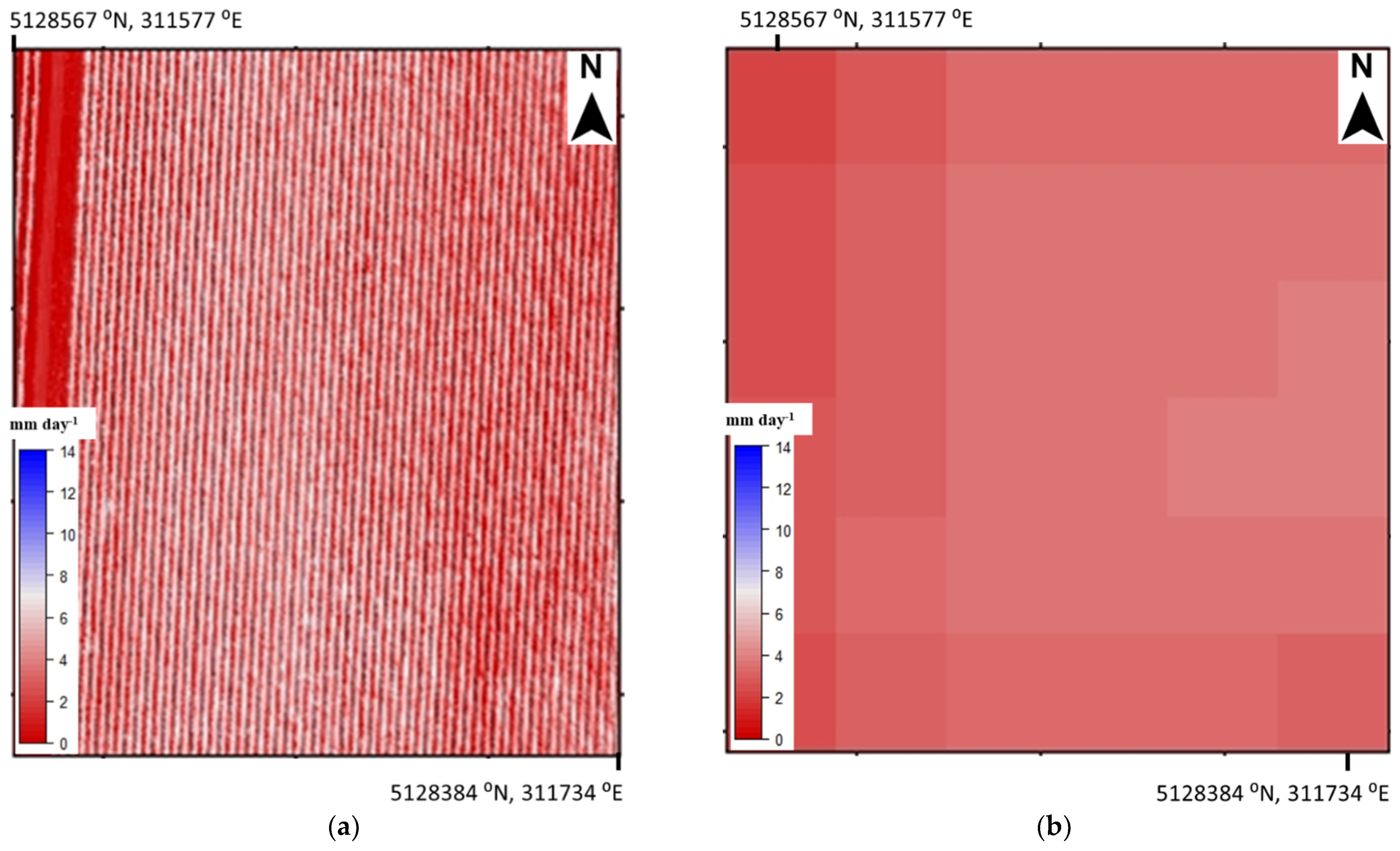
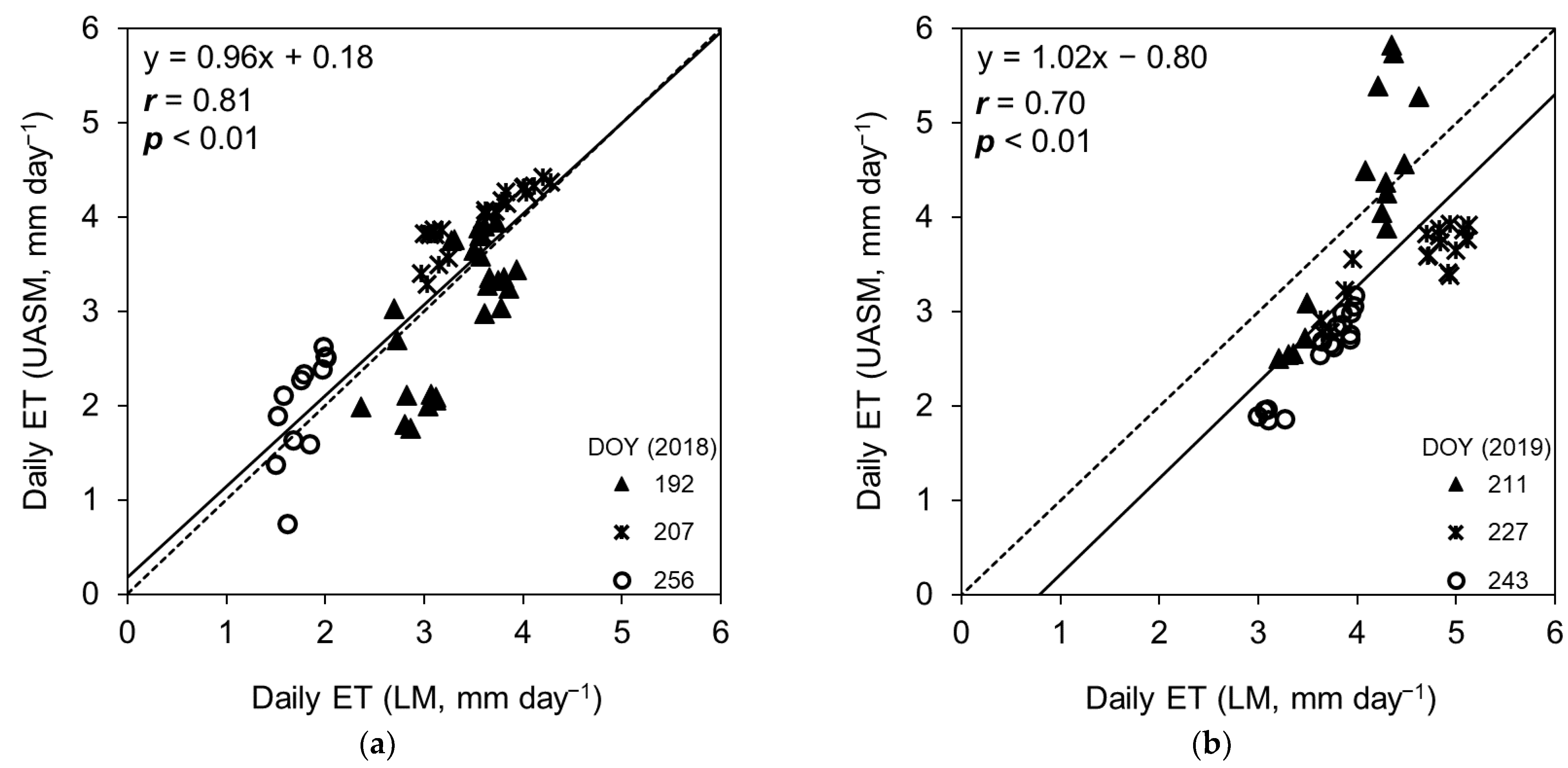
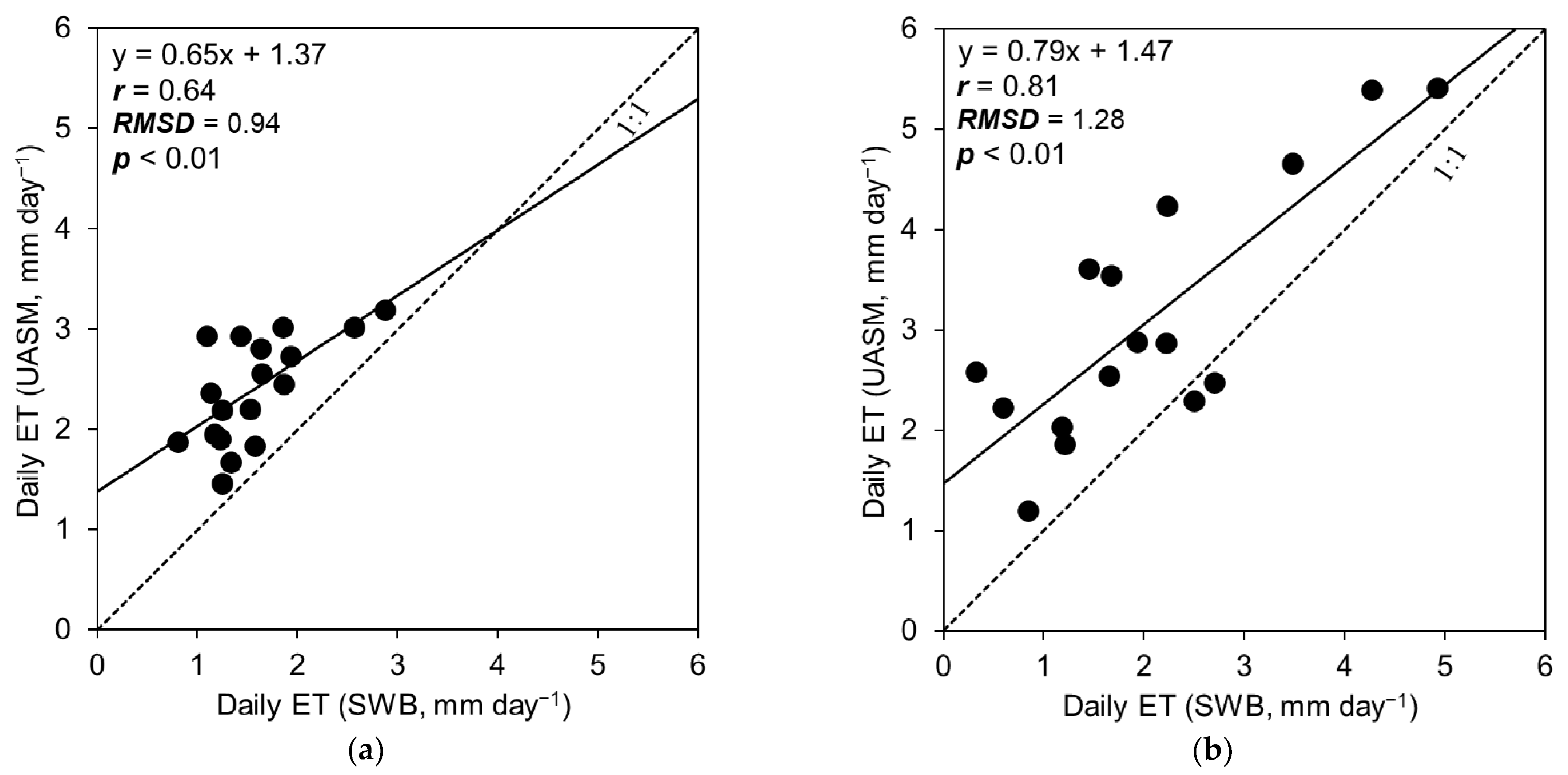


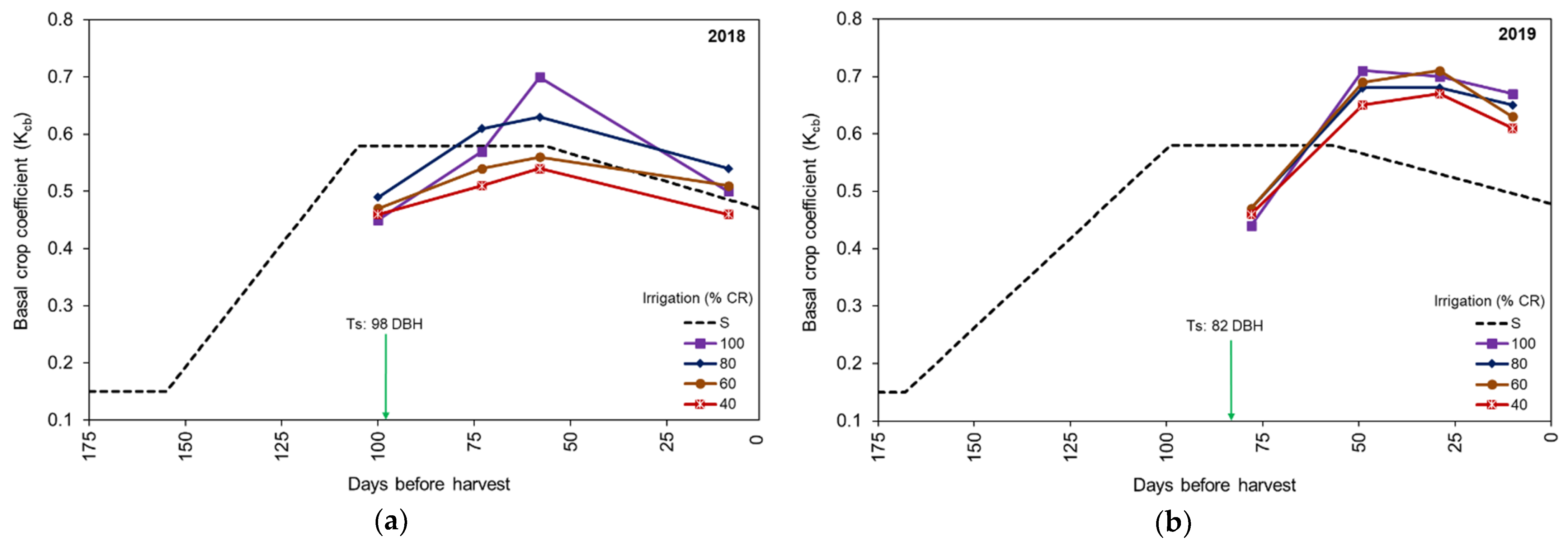

| Year: 2018 | ||||||||||||
| Parameter/Month | Jan | Feb | Mar | Apr | May | Jun | Jul | Aug | Sep | Oct | Nov | Dec |
| Mean minimum air temperature (°C) | 0.7 | −0.3 | 1.1 | 5.8 | 11.8 | 11.9 | 15.8 | 15.0 | 9.7 | 5.5 | 0.6 | −0.1 |
| Mean air temperature (°C) | 3.8 | 4.4 | 7.7 | 12.2 | 20.1 | 20.9 | 26.3 | 24.0 | 17.9 | 11.3 | 4.6 | 2.9 |
| Mean maximum air temperature (°C) | 7.0 | 9.5 | 14.3 | 18.9 | 27.9 | 29.0 | 35.7 | 32.9 | 26.2 | 18.1 | 9.4 | 6.0 |
| Mean relative humidity (%) | 87.5 | 65.4 | 60.8 | 56.2 | 49.7 | 43.7 | 34.8 | 42.5 | 47.4 | 71.4 | 81.9 | 80.9 |
| Mean wind speed (m s−1) | 1.7 | 2.8 | 2.3 | 2.6 | 1.8 | 2.0 | 1.6 | 1.6 | 1.6 | 1.5 | 1.6 | 1.8 |
| Total solar radiation (MJ m−2) | 122 | 234 | 403 | 543 | 716 | 779 | 847 | 630 | 512 | 315 | 158 | 94 |
| Total reference evapotranspiration (alfalfa-based, ETr, mm) | 25.5 | 63.5 | 99.8 | 151.8 | 208.9 | 234.0 | 275.0 | 220.4 | 150.2 | 72.0 | 43.0 | 30.2 |
| Total precipitation (mm) | 28.7 | 7.6 | 2.3 | 35.1 | 5.3 | 3.3 | 0.0 | 0.0 | 0.0 | 20.8 | 16.0 | 31.0 |
| Year: 2019 | ||||||||||||
| Parameter/Month | Jan | Feb | Mar | Apr | May | Jun | Jul | Aug | Sep | Oct | Nov | Dec |
| Mean minimum air temperature (°C) | −0.5 | −6.7 | −2.0 | 7.2 | 10.6 | 12.7 | 14.4 | 15.8 | 12.0 | 2.9 | −1.6 | −0.9 |
| Mean air temperature (°C) | 2.2 | −3.4 | 3.5 | 13.0 | 18.3 | 21.5 | 23.6 | 24.6 | 18.4 | 9.3 | 3.4 | 1.9 |
| Mean maximum air temperature (°C) | 5.0 | 0.0 | 9.3 | 19.1 | 25.6 | 29.7 | 32.2 | 33.4 | 25.7 | 16.1 | 8.8 | 4.3 |
| Mean relative humidity (%) | 85.5 | 83.7 | 71.8 | 54.5 | 48.7 | 41.6 | 42.5 | 45.9 | 55.7 | 54.8 | 74.9 | 90.9 |
| Mean wind speed (m s−1) | 1.7 | 2.2 | 1.6 | 2.5 | 2.0 | 1.8 | 1.6 | 1.5 | 1.8 | 1.8 | 1.5 | 1.3 |
| Total solar radiation (MJ m−2) | 104 | 211 | 428 | 516 | 688 | 785 | 788 | 674 | 443 | 338 | 174 | 80 |
| Total reference evapotranspiration (alfalfa-based, ETr, mm) | 21.8 | 22.5 | 67.8 | 149.7 | 202.4 | 232.3 | 239.2 | 214.4 | 145.1 | 92.3 | 35.7 | 17.2 |
| Total precipitation (mm) | 32.8 | 35.3 | 7.9 | 18.5 | 25.2 | 7.1 | 3.3 | 8.1 | 6.6 | 16.0 | 12.5 | 15.2 |
| Parameter | Landsat-METRIC (LM) | UAS-METRIC (UASM) |
|---|---|---|
| Metadata | Landsat 7/8 overpass | Small UAS flight mission |
| Surface albedo | Landsat 7/8 imager | Small UAS imager |
| Digital elevation model (DEM) | 1-arc Shuttle Radar Topography Mission (SRTM) grids; considers variable elevation, slope, and aspect per pixel | Derived from small UAS imagery; considers constant elevation by forcing slope and aspects to zero |
| Leaf area index (LAI) | LAI = −(ln[(0.69 − SAVI)/0.59])/0.91 SAVI = ((1 + L) × (RNIR−RR))/(L + (RNIR + RR)), L = 0.1 | LAI = −(ln[(0.69 − SAVI)/0.59])/0.91 SAVI = ((1 + L) × (RNIR−RR))/(L + (RNIR + RR)), L = 0.5 |
| Incoming short-wave radiation (ISWR) | Rs↓ = Gsc × cosθrel × τsw/d2 cos θrel calculated for non-horizontal surface using surface slopes and aspect | Rs↓= Gsc × cosθrel × τsw/d2 cos θrel calculated for horizontal surface by forcing surface slope and aspect to zero |
| Incoming long-wave radiation (ILWR) | RL↓ = εaσTs4 | RL↓ = εaσTs4 |
| Momentum roughness length (Zom) | Zom = 0.018 × LAI Zom,mtn = Zom × (1 + (((180 × S)/π) − 5)/20) | Equation (1) |
| Season | DOY | DBH | ETr | Approach | Transpiration (T) | TrF (Kcb) | Td | ||
|---|---|---|---|---|---|---|---|---|---|
| Mean | Std. Dev. | ||||||||
| (mm day−1) | (mm day−1) | (mm day−1) | r (T) | ||||||
| 2018 | 192 | 72 | 8.35 | UASM | 5.35 | 1.54 | 0.64 | 0.51 | 0.95 |
| FAO-Kcb | 4.84 | - | 0.58 | ||||||
| 207 | 57 | 9.03 | UASM | 5.06 | 1.50 | 0.56 | −0.02 | ||
| FAO-Kcb | 5.24 | - | 0.58 | ||||||
| 256 | 8 | 5.37 | UASM | 2.75 | 1.23 | 0.51 | 0.02 | ||
| FAO-Kcb | 2.63 | - | 0.49 | ||||||
| 2019 | 211 | 71 | 8.24 | UASM | 5.86 | 1.77 | 0.71 | 1.08 | |
| FAO-Kcb | 4.78 | - | 0.58 | ||||||
| 227 | 55 | 7.79 | UASM | 5.34 | 1.96 | 0.69 | 0.89 | ||
| FAO-Kcb | 4.45 | - | 0.57 | ||||||
| 266 | 10 | 3.94 | UASM | 2.58 | 0.91 | 0.65 | 0.61 | ||
| FAO-Kcb | 1.97 | - | 0.50 | ||||||
Publisher’s Note: MDPI stays neutral with regard to jurisdictional claims in published maps and institutional affiliations. |
© 2021 by the authors. Licensee MDPI, Basel, Switzerland. This article is an open access article distributed under the terms and conditions of the Creative Commons Attribution (CC BY) license (http://creativecommons.org/licenses/by/4.0/).
Share and Cite
Chandel, A.K.; Khot, L.R.; Molaei, B.; Peters, R.T.; Stöckle, C.O.; Jacoby, P.W. High-Resolution Spatiotemporal Water Use Mapping of Surface and Direct-Root-Zone Drip-Irrigated Grapevines Using UAS-Based Thermal and Multispectral Remote Sensing. Remote Sens. 2021, 13, 954. https://doi.org/10.3390/rs13050954
Chandel AK, Khot LR, Molaei B, Peters RT, Stöckle CO, Jacoby PW. High-Resolution Spatiotemporal Water Use Mapping of Surface and Direct-Root-Zone Drip-Irrigated Grapevines Using UAS-Based Thermal and Multispectral Remote Sensing. Remote Sensing. 2021; 13(5):954. https://doi.org/10.3390/rs13050954
Chicago/Turabian StyleChandel, Abhilash K., Lav R. Khot, Behnaz Molaei, R. Troy Peters, Claudio O. Stöckle, and Pete W. Jacoby. 2021. "High-Resolution Spatiotemporal Water Use Mapping of Surface and Direct-Root-Zone Drip-Irrigated Grapevines Using UAS-Based Thermal and Multispectral Remote Sensing" Remote Sensing 13, no. 5: 954. https://doi.org/10.3390/rs13050954
APA StyleChandel, A. K., Khot, L. R., Molaei, B., Peters, R. T., Stöckle, C. O., & Jacoby, P. W. (2021). High-Resolution Spatiotemporal Water Use Mapping of Surface and Direct-Root-Zone Drip-Irrigated Grapevines Using UAS-Based Thermal and Multispectral Remote Sensing. Remote Sensing, 13(5), 954. https://doi.org/10.3390/rs13050954








